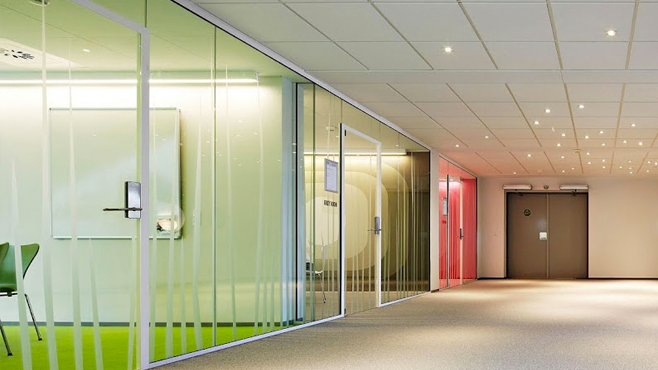for support
(888)123-4567
With technology breaking the traditional model of 9-5 office work, the way we approach work has gone through significant changes.
Today, “I’m in the office” can mean anywhere from being in a regular office building, hammering away at the laptop from the comfort of one’s room, or sipping a margarita beach side. As big businesses and corporations see the competition get tougher, and see the benefits of taking a cue from their startup counterparts.
Greater mobility in the way businesses operate means a shift from the larger traditional office space taken up by one company towards different permutations, as certain employees can get their work done remotely, businesses need to have the advantage of flexibility in rent and scalability, while having ease of access to other resources and allies. Experts believe that coworking will be the trajectory of an ideal workspace that businesses will move to.
Co-working is perfect for businesses, entrepreneurs, and freelancers, providing a revolving door of new and recurring contacts and clients.
However, the nature of co-working results in the greatest foot traffic coming from both personnel and visitors that a professional working space would see. Add to that tenancy options that range from possibly a few years, to just a day or two, and you can see the flexibility of the co-working space becoming a concern for security.
An interesting article charts the history of locks and keys, and with personnel and companies shifting and changing at such a rapid pace, the traditional lock and key for the main gate won’t suffice. With multiple keyless systems, there are challenges abound, that show a lapse and the hurdles that are presented with keyless technology.
Keyless technology for businesses has to find the balance that matches three factors. Robust security measures, ease in granting and modifying access for users, and non-fragmentation in hardware and software implementations. To be able to work as part of a co-working space management software/technology has to be the benchmark. Below are a few pointers we believe should be taken into consideration for co-working space managers.
1) The co-working space management software your team has should go beyond keyless and be invisible to anyone else

Many co-working space managers become the face of the co-working space, standing as the constant in a place where other businesses and entrepreneurs come and go, they also serve as the first point of personal contact for tenants.
Keyless systems that you want to implement for the space needs to provide the management team beyond just keyless functionalities.
With so many software suites in the market, empowering your team with keyless integrations that double up as a POS system will streamline their workflow much easier. A keyless solution that combines these two aspects together, and provides your co-working space management team the right notifications can double as a comprehensive sales tool.
The implementation possibilities are endless - management of bookings and reservations of offices and desks by availability, getting in touch with tenants whose leases are about to end, and serving tenants who enjoy the environment and want extended services and space. These will all be made possible without having them filling up countless forms. In fact, do away with paper documentation, and go full digital.
All this has to happen in the background, unseen to the user, and be of a concern only to the co-working space management team.
2) Robust security measures

Managing security for keyless systems has a few crucial touchpoints that we need to address. Solutions such as passcodes and access key cards may work well but are not the most efficient when you have multiple doors and areas that require different levels of access. It certainly doesn't help too when tenants or visitors come and go, requiring staff to escort and show around, disrupting their work. With transient traffic in co-working, this constant verification and registration process will be a nightmare, and many building managers might be reluctant and uncomfortable going through that process.
Taking a cue from the banks, a validation approach that isn't intrusive on privacy has to be introduced, and one that doesn’t need both users, and co-working space manager to jump through hoops to work. Taking the user’s smartphone, and tagging it along with fingerprint verification as part of an app for the keyless system turns it to a 2 step verification process.
The app on the user side has to be linked to a framework with good encryption technology that the co-working space manager can have easy access to while protecting the user’s information.
3) Ease in granting and modifying access

The building layout plans are easily accessible by the co-working space management, and access to the right rooms and doors can be granted to the user. By limiting and granting access to each individual user, the space is able to funnel and lead people down to the right rooms, without the hassle of exchanging multiple passes and verifying access rights and schedules. And in the case they try to enter the wrong meeting room, they will be denied access.
In some cases, when visitors do come and bring their colleagues unannounced, the co-working space manager can oversee this onboarding process painlessly, and to transfer the same rights and privileges to the newcomers. With the database and app installed, co-working space managers can set the time and dates of users coming in advance. The times are especially useful for co-working spaces where certain arrangements are date and time sensitive, such as the rights to 24/7 access to some users, and not all.
4) Non-fragmentation in hardware and software implementations

You will be looking at a few moving parts for keyless to work in the future, security has to be both ironclads offline and online, it has to work in sync, and onboarding processes need to be hassle-free.
The issue with a keyless solution is the pitfall of hardware and software fragmentation. Being able to leverage existing hardware and software would be ideal. The devices and tools for an office space to implement should be minimally intrusive for fast uptake, and to make scaling to multiple offices simple. For co-working spaces with multiple venues, this is especially important, as most co-working spaces allow their users access to multiple sites.
Non-fragmentation also means keeping up to date in making sure OS, software, and firmware updates do not impede in the operations of the keyless system.
Take a look to see how keyless can work for you.
Check out our weekly GTRIIP blog post updates, as we explore the possibilities of keyless technology, new advancements in our workplace and share our views and insights, and opinions on a variety of topics.